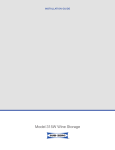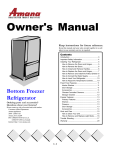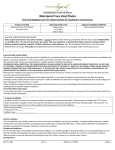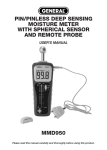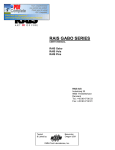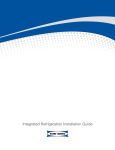Download Maytag MBF2256KEW - Bottom Freezer Refridgerator Use & care guide
Transcript
Important Safety Instructions DANGER Installer: Please leave this guide with this appliance. Consumer: Please read and keep this Use & Care Guide for future reference. This guide provides proper use and maintenance information. Keep sales receipt and/or cancelled check as proof of purchase. Call: 1-800-688-9900 U.S.A. 1-800-688-2002 Canada Have complete model and serial number identification of your refrigerator. This is located on a data plate inside the refrigerator compartment, on the upper left side. Record these numbers below for easy access. Model Number _______________________________ Revision Number ______________________________ To reduce risk of injury or death, follow basic precautions, including the following: IMPORTANT: Child entrapment and suffocation are not problems of the past. Junked or abandoned refrigerators are still dangerous – even if they sit out for “just a few days.” If you are getting rid of your old refrigerator, please follow the instructions below to help prevent accidents. Before you throw away your old refrigerator or freezer: • Take off the doors. • Leave the shelves in place so children may not easily climb inside. Serial Number ________________________________ Date of Purchase ______________________________ In our continuing effort to improve the quality and performance of our appliances, it may be necessary to make changes to the appliance without revising this guide. What You Need to Know About Safety Instructions Warning and Important Safety Instructions appearing in this guide are not meant to cover all possible conditions and situations that may occur. Common sense, caution and care must be exercised when installing, maintaining or operating appliance. This appliance is equipped with a three-prong grounding plug for your protection against possible electrical shock hazards. It must be plugged into a grounding receptacle. Where a standard two-prong wall receptacle is encountered, it is the personal responsibility and obligation of the customer to have it replaced with a properly grounded three-prong wall receptacle. Do not under any circumstances, cut or remove the third (ground) prong from the power cord. Do not use an adapter plug. Power supply cord with three-prong grounding plug Always contact the manufacturer about problems or conditions you do not understand. Recognize Safety Symbols, Words, Labels DANGER DANGER – Immediate hazards which WILL result in severe personal injury or death. WARNING WARNING – Hazards or unsafe practices which COULD result in severe personal injury or death. CAUTION CAUTION – Hazards or unsafe practices which COULD result in minor personal injury or property damage. 1 Grounding type wall receptacle Important Safety Instructions WARNING To reduce risk of fire, electric shock, serious injury or death when using your refrigerator, follow these basic precautions, including the following: 13. Always disconnect refrigerator from electrical supply before attempting any service. Disconnect power cord by grasping the plug, not the cord. 1. Read all instructions before using the refrigerator. 14. Install refrigerator according to Installation Instructions. All connections for water, electrical power and grounding must comply with local codes and be made by licensed personnel when required. 2. Observe all local codes and ordinances. 3. Be sure to follow grounding instructions. 4. Check with a qualified electrician if you are not sure this appliance is properly grounded. 5. Do not ground to a gas line. 6. Do not ground to a cold-water pipe. 7. Refrigerator is designed to operate on a separate 115 volt, 15 amp., 60 cycle line. 15. Keep your refrigerator in good condition. Bumping or dropping refrigerator can damage refrigerator or cause refrigerator to malfunction or leak. If damage occurs, have refrigerator checked by qualified service technician. 16. Replace worn power cords and/or loose plugs. 8. Do not modify plug on power cord. If plug does not fit electrical outlet, have proper outlet installed by a qualified electrician. 17. Always read and follow manufacturer’s storage and ideal environment instructions for items being stored in refrigerator. 9. Do not use a two-prong adapter, extension cord or power strip. 18. Your refrigerator should not be operated in the presence of explosive fumes. 10. Do not remove warning tag from power cord. 11. Do not tamper with refrigerator controls. 12. Do not service or replace any part of refrigerator unless specifically recommended in Use & Care Guide or published user-repair instructions. Do not attempt service if instructions are not understood or if they are beyond personal skill level. 19. Children should not climb, hang or stand on any part of the refrigerator. 20. Clean up spills or water leakage associated with water installation. SAVE THESE INSTRUCTIONS 2 Installation Your refrigerator was packed carefully for shipment. Remove and discard shelf packaging and tape. Do not remove the serial plate. Location • Do not install refrigerator near oven, radiator or other heat source. If not possible, shield refrigerator with cabinet material. • Do not install where temperature falls below 55° F (13° C) or rises above 110° F (43° C). Malfunction may occur at this temperature. • Refrigerator is designed for indoor household application only. Measuring the Opening When installing your refrigerator, measure carefully. Allow 1⁄2" space at top and 1⁄2" space behind the machine compartment cover (located in the rear) for proper air circulation. Subflooring or floor coverings (i.e. carpet, tile, wood floors, rugs) may make your opening smaller than anticipated. Some clearance may be gained by using the leveling procedure under Leveling. IMPORTANT: If refrigerator is to be installed into a recess where the top of the refrigerator is completely covered, use dimensions from floor to top of hinge cap to verify proper clearance. Transporting Your Refrigerator • NEVER transport refrigerator on its side. If an upright position is not possible, lay refrigerator on its back. Allow refrigerator to sit upright for approximately 30 minutes before plugging it in to assure oil returns to the compressor. Plugging the refrigerator in immediately may cause damage to internal parts. • Use an appliance dolly when moving refrigerator. ALWAYS truck refrigerator from its side or back–NEVER from its front. • Protect outside finish of refrigerator during transport by wrapping cabinet in blankets or inserting padding between the refrigerator and dolly. • Secure refrigerator to dolly firmly with straps or bungee cords. Thread straps through handles when possible. Do not overtighten. Overtightening 3 restraints may dent or damage outside finish. Leveling CAUTION To protect property and refrigerator from damage, observe the following: • Protect vinyl or other flooring with cardboard, rugs, or other protective material. • Do not use power tools when performing leveling procedure. To enhance the appearance and maintain performance, the refrigerator should be level. Note • Complete any required door reversal, panel installation and/or a water supply connection, before leveling. Materials Needed • 3⁄8" hex head driver • Carpenter’s level 1. Remove toe grille. • Grasp firmly and pull outward to unclip. 2. Remove bottom bracket cover(s). • Place the eraser end of a pencil or similar blunt tool in the cover notch. Notch Location • Use slight pressure to pry the cover loose. • Continue to maintain downward pressure to the notched side of the cover while swinging it off. Installation 3. Using hex head driver, turn the front adjustment screws (A) on each side to raise or lower the front of the refrigerator. A B BA Door and Drawer Removal Some installations require door/drawer removal to transport the refrigerator to its final location. WARNING To avoid electrical shock which can cause severe personal injury or death, observe the following: C C Note • Some models only have adjustment screws “A.” 4. Select models also have rear adjustment screws (B). Using the hex head driver, turn each of these adjustment screws (B) to raise or lower the rear of the refrigerator. 5. Using the carpenter’s level, make sure front of refrigerator is 1⁄4" (6 mm) or 1⁄2 bubble higher than back of refrigerator and that the refrigerator is level from side to side. 6. Turn stabilizing legs (C) clockwise until firmly against floor. 7. Freezer drawer models only: Turn adjustment screws (A) counterclockwise to allow the full weight of the refrigerator to rest on the stabilizing legs. 8. Replace bracket cover(s). • Position cover into the outer edge of the hinge. • Swing the cover toward the cabinet and snap it into place. 9. Replace the toe grille. Note • For proper reinstallation, ensure the “top” marking on the interior of the toe grille is oriented correctly. • Align the toe grille mounting clips with the lower cabinet slots. • Push the toe grille firmly until it snaps into place. • Disconnect power to refrigerator before removing doors or drawer. Connect power only after replacing doors or drawer. CAUTION To avoid damage to walls and flooring, protect vinyl or other flooring with cardboard, rugs or other protective material. 1. Unplug power cord from power source. 2. Remove toe grille and bottom bracket cover(s) (see page 3). 3. Remove top hinge cover from refrigerator door by removing Phillips screw and retain screw and cover for later use. 4. Unscrew 5⁄16" hex head screws from top hinge to remove hinge and retain all screws for later use. 5. Lift refrigerator door from center hinge pin. 6. For swing freezer door models only: Hold freezer door while removing hinge pin with a 5⁄16" hex head driver. Remove door from bottom hinge and retain hinge pin for later use. For pullout freezer drawer models only: Remove plastic sleeve, if present. Remove center hinge pin with a 5⁄16" hex head driver. Retain hinge pin and plastic sleeve for later use. 7. Remove Phillips screws to remove center hinge and retain all screws for later use. 8. Remove bottom hinge or stabilizing bracket with 3⁄8" hex head driver and retain screws for later use. Lift out bottom hinge pin (on freezer door models). 9. If your model has a pullout freezer drawer, see page 5 for drawer removal instructions. 4 Installation Pullout Freezer Drawer To Install: 1. Pull both rails out to full extension. (select models) DANGER To prevent accidental child entrapment or suffocation risk, do not remove the divider in the top freezer basket. WARNING 2. While supporting door front, hook supports into tabs located on inside of rail. To avoid electrical shock which can cause severe personal injury or death, disconnect power to refrigerator before removing doors. After replacing doors, connect power. CAUTION 3. Lower door front into final position. To avoid possible injury, product, or property damage, you will need two people to perform the following instructions. To Remove: 1. Pull drawer open to full extension. 2. Pull upper basket out to full extension and lift out to remove. 3. Lift lower basket straight up and out to remove. 4. On each side rail is a basket cradle with two snap attachments. To release each cradle, unlatch the snaps by pushing them inward, away from the side rail system. Lift the cradles off of the rails. 4. Replace and tighten Phillips screws that were removed from each side of rail system (select models). 5. Place the basket cradles back onto the side rails. Align snaps with the slots on the side rails and press each snap towards the rail until it clicks. 6. With rails pulled out to full extension, set the basket straight down into the basket cradles. Basket cradle snap attachments 5. Remove Phillips screw from each side of rail system (select models). 7. Slide upper basket into freezer. Make sure that rear of basket hooks behind rail catch. 6. Lift top of drawer front to unhook supports from rail system. Lift door front out to remove. 5 Installation Reinstallation of the Doors 1. Install hinge assemblies: CAUTION To avoid possible injury and damage to property: • Install top hinge loosely with ⁄16" hex head screws. 5 • Install center hinge with Phillips screws. • Freezer door models: Install bottom hinge with 3 ⁄8" hex head screws. 2. Freezer door models: Insert bottom hinge pin. • Locate bottom hinge hole closest to outside edge of cabinet, and insert bottom hinge pin. Replace any door shims, if present. 3. Freezer door models: Place hinge side of freezer door on bottom hinge pin and hold freezer door upright while installing center hinge pin with 5 ⁄16" hex head driver. • Replace plastic sleeve. • Replace any applicable door shims. • Make sure the hinge pin is installed tightly. 4. Place hinge side of refrigerator door on center hinge pin. 5. While holding refrigerator door upright, tighten down top hinge with 5⁄16" hex head driver and replace hinge cover. Door Reversal In some installations, reversing the door swing allows for more convenient access to stored items. Both doors can be reversed on freezer door models and the fresh food door is reversible on freezer drawer models. 1. Remove door(s) (see page 4). 2. Transfer cabinet plugs and cabinet screws to opposite side of cabinet. • Remove cabinet plugs with flat blade of screwdriver tip wrapped in masking tape. • Place doors on a nonabrasive surface protected by towels or rugs while working directly on doors. 3. Transfer door stops from bottom edge of fresh food door and freezer door, if applicable, to opposite side of door edge. • Use a Phillips screwdriver for removal and installation. 4. Install handles (see pages 6 and 7). 5. Reinstall the door(s). Handles If not installed, the handle is located in the interior of the fresh food section or attached to the back of your refrigerator. Remove and discard handle packaging and tape. Handle design varies from refrigerator to refrigerator. Please reference the appropriate instructions for your model below. Fresh Food Handles Standard Front Mount Handle Materials Needed • Phillips screwdriver • 5⁄16" hex head driver To Install: 1. Remove 1⁄4" hex head screws from door face with hex head driver, and Phillips screw from top of door. • If reversing door, remove door plugs from opposite side of door and insert in screw holes. 2. Align handle holes with screw holes on door face and secure with two door face screws from step 1. • Remove center mullion screws with 5⁄16" hex head screwdriver. • Freezer door models: Remove bottom mullion screws with 3⁄8" hex head driver. 6 Installation 3. Locate handle trim in literature pack and install over top and bottom of handle, as illustrated. • Secure top handle trim with remaining screw removed in step 1. • Snap bottom trim over bottom portion of handle. To Remove: 1. Remove top handle trim by removing top handle screw. • Retain trim and screw for later replacement. 2. Pry bottom handle trim from handle with screwdriver flat blade wrapped in masking tape. Freezer Handles Partial-Width Handle Materials Needed • Phillips screwdriver To Install: 1. Install handle by fastening with screws removed from edge of door. • If reversing freezer door, remove door plugs from top edge of door and insert into screw holes. To Remove: 1. Remove handle screws with Phillips screwdriver and retain screws for later use. • Retain trim for later replacement. 3. Remove two hex head screws. • Retain screws for later replacement. Front Mount Freezer Handle Materials Needed • Gloves to protect hands. • Phillips screwdriver. • Plastic handle removal card (or 1⁄32" thick plastic card). Retain the card. Side Mount Handle Materials Needed • Phillips screwdriver To Install: Notes 1. Remove screws from the side of the door. 2. Align the side mount handle with the predrilled holes in the door panel. 3. Insert the screws in the sequence as shown. Upper Handle 1 3 2 4 Lower Handle 4. Ensure the door handle is snug to the door panel. To Remove: Reverse installation procedure. 7 • There is a slight curve to this style of freezer handle. • For proper installation, be sure handle is oriented as shown. To Install: 1. Align door handle clips slightly to the left of the tabs attached to the freezer door. 2. Rotate the handle so the left base is flat against the door. Handle Clip Door Tab Handle Base Installation 3. Push the left handle base against the left door tab and slightly to the right, just enough to allow it to hang unsupported. 4. While firmly supporting the left handle base against the door, align the right base of the handle with the right tabs that are attached to the door. 5. Now, while firmly holding the handle at the left and right bases, gently slide the handle towards the right until the right base settles in. The handle should now be flat against the face of the freezer door at both the left and right bases. To Remove: 1. At the right end, flex the handle base away from the surface of the freezer drawer. Simultaneously slide the door handle removal card that came with your refrigerator under the right side base of the handle. Slide the card to the line indication or until it stops, which will be approximately 11⁄2". 2. With both hands, firmly grasp the handle towards the right base. 3. Slide towards the left, lift and remove from the surface. 6. With hands still firmly keeping the handle flat against the freezer door, you may have to reverse directions momentarily to assure clip/tab engagement. Then firmly slide the handle to the right until it clicks. The audible "click" indicates that the fastening clips are securely interlocked. 8 Installation Connecting the Water Supply Materials Needed (select models) • 1⁄4" outer diameter flexible copper tubing • Shut-off valve (requires a 1⁄4" hole to be drilled into water supply line before valve attachment) • Adjustable wrench • 1⁄4" hex nut driver WARNING To reduce the risk of injury or death, follow basic precautions, including the following: • Read all instructions before installing ice maker. Note • Do not attempt installation if instructions are not understood or if they are beyond personal skill level. • Add 8' to tubing length needed to reach water supply for creation of service loop. • Observe all local codes and ordinances. 1. Create service loop with copper tubing (minimum 2’ diameter). Avoid kinks in the copper tubing when bending it into a service loop. • Do not service ice maker unless specifically recommended in Use & Care Guide or published user-repair instructions. • Disconnect power to refrigerator before installing ice maker. • Water damage due to an improper water connection may cause mold/mildew growth. Clean up spills or leakage immediately . CAUTION To avoid property damage or possible injury, follow basic precautions, including the following: • Consult a plumber to connect 1⁄4” O.D. copper tubing to household plumbing to assure compliance with local codes and ordinances. • Confirm water pressure to water valve is between 35 and 100 pounds per square inch. 20 pounds per square inch if there is not a water filter. • Do not use a self-piercing, or 3⁄16" saddle valve. Both reduce water flow and can become clogged over time, and may cause leaks if repair is attempted. • Tighten nuts by hand to prevent cross threading. Finish tightening nuts with pliers and wrenches. Do not overtighten. • Wait 2-3 hours before placing refrigerator into final position to check and correct any water leaks. Recheck for leaks after 24 hours. • Verify the copper tubing under the sleeve is smooth and free from defects. Do not reuse an old sleeve. 9 2’ diameter minimum 2. Remove plastic cap from water valve inlet port. 3. Place brass nut (A) and sleeve (B) on copper tube end as illustrated. A Reminder: Do not use an old sleeve. B 4. Place end of copper tubing into water valve inlet port. Shape tubing slightly. Do not kink – so that tubing feeds straight into inlet port. 5. Slide brass nut over sleeve and screw nut into inlet port. Tighten nut with wrench. IMPORTANT: Do not overtighten. Cross threading may occur. 6. Pull on tubing to confirm connection is secure. Connect tubing to frame with water tubing clamp (C) and turn on water supply. Check for leaks and correct if necessary. Continue to observe the water supply connection for two to three hours prior to moving the refrigerator to its permanent location. C 7. Monitor water connection for 24 hours. Correct leaks, if necessary.











